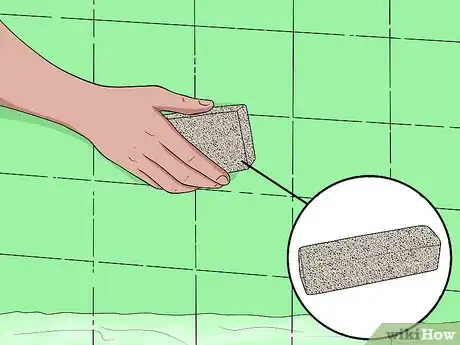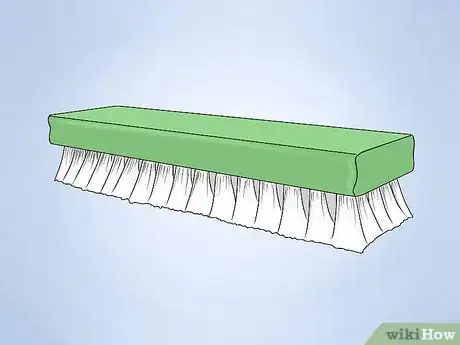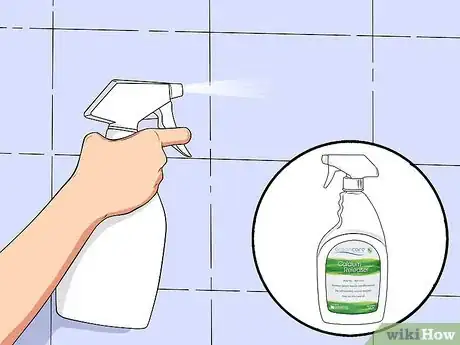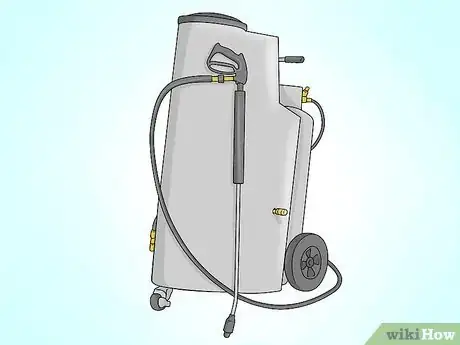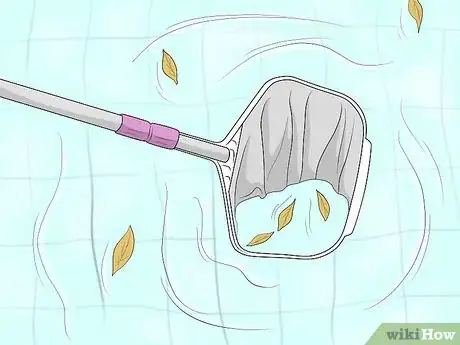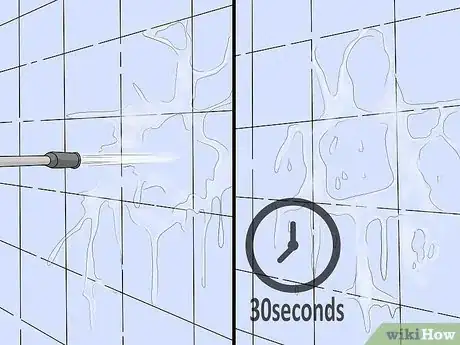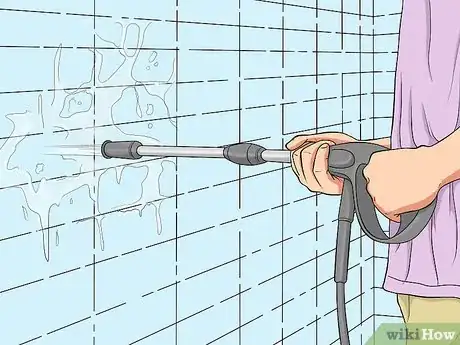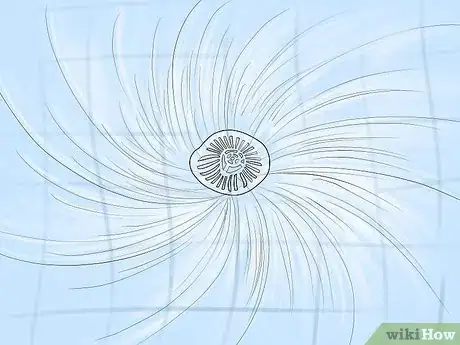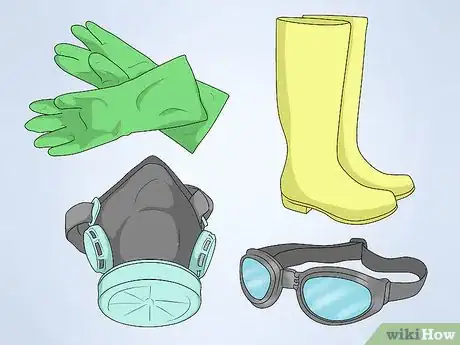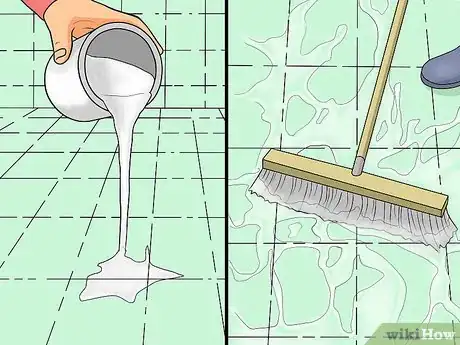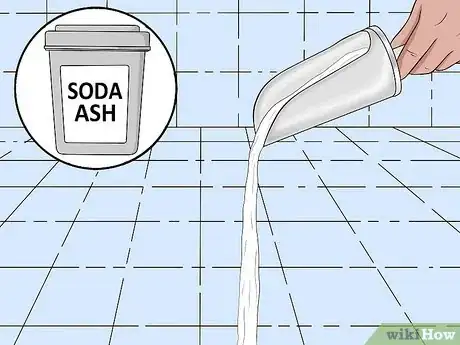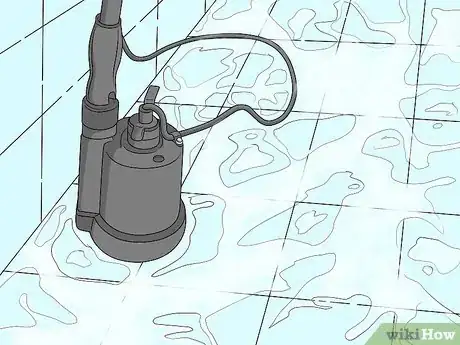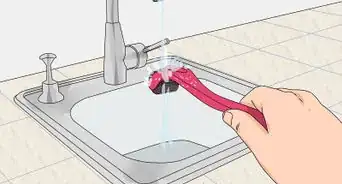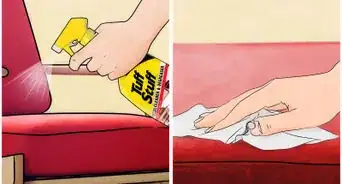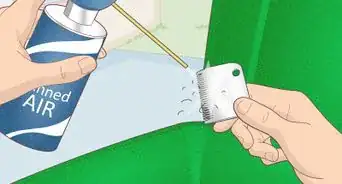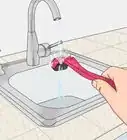This article was co-authored by wikiHow Staff. Our trained team of editors and researchers validate articles for accuracy and comprehensiveness. wikiHow's Content Management Team carefully monitors the work from our editorial staff to ensure that each article is backed by trusted research and meets our high quality standards.
This article has been viewed 43,635 times.
Learn more...
How you clean your tiles depends on what kind of calcium build-up they have. If your tiles only contain calcium carbonate scaling (minimal build-up), then use a pumice stone or a nylon bristle brush to remove scaling, mildew, and grime. However, if your pool tiles contain calcium silicate scaling, you may need to use a steam pressure washer or an acid solution to clean your pool tiles. If this is you, make sure to take the necessary precautions to prevent injury and harm.
Steps
Cleaning Calcium Carbonate Scaling
-
1Use a pumice stone. Because calcium carbonate scaling is white and flakey, it is easy to remove with a pumice stone. You can purchase pumice stones from your local pool maintenance store or online.[1]
- Pumice stone is safe to use on hard surfaces such as tile and concrete. It can be used on both concrete and plaster pools.
- Do not use pumice stone on vinyl or fiberglass pools.
-
2Try a nylon bristle brush. Use a nylon brush if your tiles are glass, ceramic or porcelain. A nylon brush will not scratch these tiles. As an alternative, you can use a 3M blue or white nylon scrub pad.Advertisement
-
3Spray a releaser. Releasers, such as the Ocean Care Calcium Releaser, will soften the calcium for removal. The Ocean Care Calcium Releaser is acid-free, biodegradable, and non-toxic, making it safe to use without having to drain your pool completely.
-
4Scrub the tile in a circular motion. Scrub the tiles until deposits, mildew, and build-up are gone. If using a pumice stone, make sure both the tile and the stone are wet at all times while cleaning. This will prevent any scratching.[2]
- You may wear latex gloves to protect your hands while cleaning, but it is not necessary.
Pressure Washing Your Pool Tiles
-
1Rent a pressure washer from your local hardware store. Choose a steam pressure washer with a PSI of 2000 to 2600 and one that can reach a temperature of at least 300 degrees Fahrenheit (149 degrees Celsius). The pressure and temperature will enable you to clean your pool tiles quickly and effectively.[3]
- With steam pressure washers, you do not need to pretreat the tile with chemicals or detergents.
-
2Remove debris around the pool. Debris such as branches, leaves, twigs, and trash should be swept up and removed before using the pressure washer. Also remove lose furniture and objects that can be easily swept away such as plants, pool equipment and toys, lawn furniture, grills, and other lose objects.[4]
-
3Test a small area first. Set the machine according to the manual's instructions. Start with a low setting and the least powerful nozzle first. Pick an inconspicuous spot and stand at least three feet away from it. Spray the area for 30 seconds. After 30 seconds, stop and check the spot to make sure the surface is not damaged.[5]
- Make sure all the outlets, inlets, and accessories are perfectly connected and secured before turning the pressure washer on.
- For your safety, make sure to wear safety goggles, close-toed shoes, and protective clothing that can get wet.
-
4Wash your pool in sections. Turn the pressure washer up to a higher setting, for example 2000 to 2600 PSI at 200 degrees Fahrenheit (93 degrees Celsius), and begin washing the pool in small sections. Use the washer's wands and attachments to reach tight corners and crevices when you need to.[6]
- If you are having a tough time removing the scaling from the tiles, then turn the temperature up to 300 degrees Fahrenheit (149 degrees Celsius).
- Remember to stand at least three feet away.
Using an Acid Solution
-
1Drain your pool. Remove debris like leaves and algae from the bottom of the pool once the water is drained. Then place your water hose at the deep-end side of the pool. Position it near the ledge so that the water will run over the tile when you turn it on.[7]
-
2Wear protective clothing. Because the acid solution emits noxious fumes and is harmful if it gets onto your skin and body, rubber boots, safety gloves and goggles, and a respirator with an acid approved filter are necessary. For extra precaution, wear a protective suit that is chemical-resistant.[8]
-
3Add 1 gallon (3.8 liters) of muriatic acid to 1 gallon of water in a bucket. You can use a plastic bucket. Make sure to slowly add the acid to the water and not the other way around. Because the acid will fizz and emit fumes when you pour it into the water, make sure you are wearing your respirator, goggles, gloves, and protective clothing.[9]
- You can purchase muriatic acid and acid-resistant cleaning tools from your local pool maintenance store or online.
-
4Apply the solution to the tile with an acid brush. Starting at the deep end of the pool, work the solution into the grout with the brush. Working on small sections at a time, scrub the tile with an acid-resistant scrub brush. Once the calcium silicate scaling is removed, rinse the tile with water using the hose.[10]
- Alternatively, fill a watering can with the solution and use the can to pour it onto the tiles. Then use the acid-resistant scrub brush to clean the tile.
- Repeat this process until all the tiles are cleaned.
-
5Add soda ash to the acidic solution at the bottom of the pool. Add 2 pounds (.9 kilograms) of soda ash for every gallon of acid. Do this once you are done cleaning all of the tiles. The soda ash neutralizes the acid so it can be safely removed from your pool.[11]
-
6Pump the neutralized acid out of the pool. Do this using a water pump. Once the acid is pumped out, rinse the pool with the hose. Then proceed to pump this water out of the pool as well. When the pool is completely rinsed and cleaned, refill it with water.[12]
- When rinsing the pool, make sure to rinse your boots, gloves, goggles, and protective clothing with water as well. Rinse until all the acid is completely gone.
- Discard any unused acid at your local hazardous waste disposal.
Community Q&A
-
QuestionHow do I clean calcium from glass pool tile?
 AnnieCommunity AnswerTry a little vinegar or a 50-50 vinegar-water solution, if it is a glass material. The lime should dissolve, but you may need to wait a little for it to do its magic. Be sure to first try it on a very small patch somewhere hidden to make sure it doesn't damage the tiles; some are not acid-resistant.
AnnieCommunity AnswerTry a little vinegar or a 50-50 vinegar-water solution, if it is a glass material. The lime should dissolve, but you may need to wait a little for it to do its magic. Be sure to first try it on a very small patch somewhere hidden to make sure it doesn't damage the tiles; some are not acid-resistant.
Things You'll Need
- Pumice stone
- Nylon bristle brush
- Calcium releaser
- Steam pressure washer
- Rubber boots
- Safety goggles
- Safety gloves
- Respirator with an acid-approved filter
- Chemical-resistant suit
- Muriatic acid
- Plastic bucket
- Acid brush
- Acid-resistant scrub brush
- Watering can
- Soda ash
- Water pump
References
- ↑ http://blog.lathampool.com/remove-calcium-scaling-in-your-swimming-pool
- ↑ http://blog.lathampool.com/remove-calcium-scaling-in-your-swimming-pool
- ↑ http://www.ultimatewasher.com/articles/pools-pressure-washing.htm
- ↑ http://www.ultimatewasher.com/articles/pools-pressure-washing.htm
- ↑ http://www.realsimple.com/home-organizing/cleaning/how-use-pressure-washer
- ↑ https://www.daimer.com/how-to-clean-swimming-pool-tiles/
- ↑ http://homeguides.sfgate.com/acid-wash-pool-tiles-32283.html
- ↑ http://homeguides.sfgate.com/acid-wash-pool-tiles-32283.html
- ↑ http://homeguides.sfgate.com/acid-wash-pool-tiles-32283.html
About This Article
To clean calcium carbonate scaling on pool tile, scrub the scaling with a pumice stone or nylon bristle brush using circular motions. Just make sure the pool tile and pumice stone or brush are wet at all times so you don't accidentally scratch the tile. If you're having a hard time getting the scaling off, try spraying the tile with a non-toxic, biodegradable calcium releaser, which will soften the scaling without damaging your pool water. To learn how to pressure wash pool tile, scroll down!
